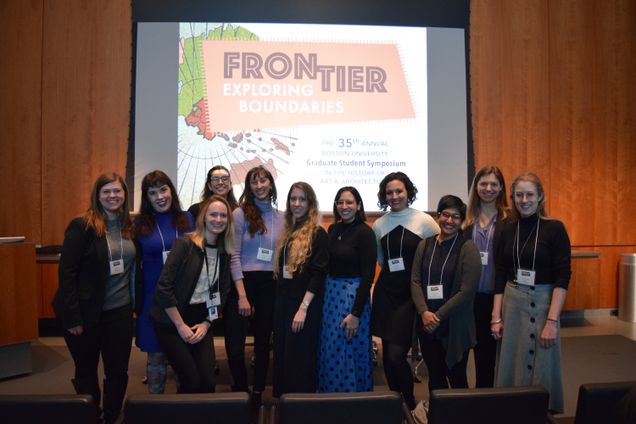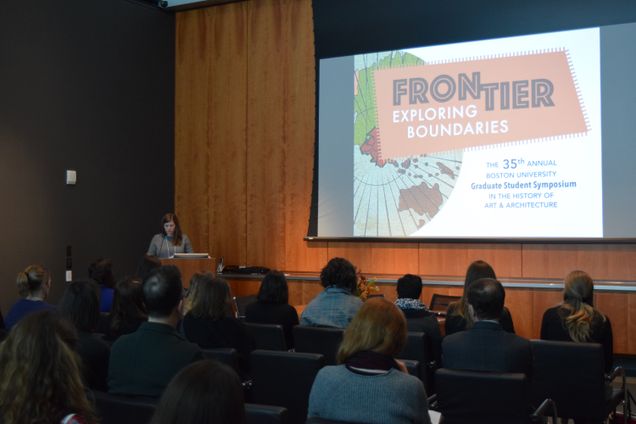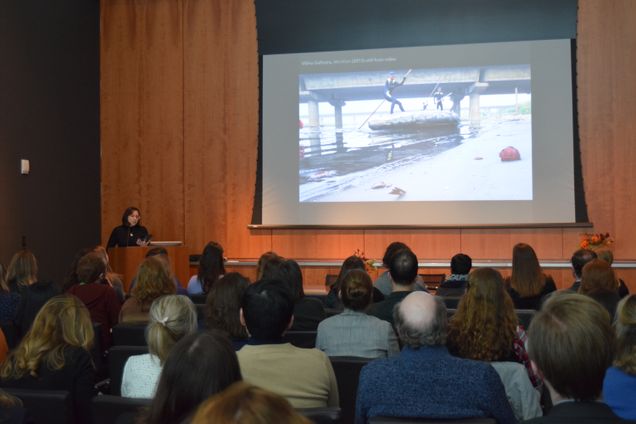Frontier: Exploring Boundaries in the History of Art and Architecture – The 35th Annual Boston University Graduate Student Symposium in the History of Art & Architecture, March 2, 2019

This event was generously sponsored by The Boston University Center for the Humanities; the Boston University Department of History of Art & Architecture; the Museum of Fine Arts, Boston; and the Boston University Graduate Student History of Art & Architecture Association.
This year marked the 35th annual Boston University Graduate Student Symposium in the History of Art and Architecture. Taking place in the Trustees Room at the Museum of Fine Arts, Boston, the symposium hosted six graduate student speakers who delivered papers exploring boundaries within the history of art and architecture. Frontiers conjure fraught historical moments, instances of subjugation and resistance, and thresholds charged with possibilities. The graduate student papers featured in this year’s symposium addressed questions of how frontiers, both physical and metaphorical, impact artistic production as creators engage with and negotiate boundaries.

The symposium took place on Saturday, March 2nd, and showcased six graduate student presentations divided into morning and afternoon panels. The morning session featured papers centering on the theme, “Border Crossings,” in an effort to highlight the liminal nature of many frontier spaces. All three speakers looked to frontiers as areas of mediation and collaboration. In the first paper of the day, “Liminal Objects, Liminal Spaces: Masterpieces of French Tapestry and the Shaping of Museum Practice,” Nushelle de Silva (MIT) addressed the transnational nature of museum exhibitions through a close examination of the first post-WWII major multinational exhibition: Masterpieces of French Tapestry. The 1946-1948 exhibition provided new opportunities for collaboration across institutions and national borders; and resulted in the codification of international museum lending practices by the end of the 1950s. The second speaker, Savannah Marlatt (University of British Columbia), explored issues of methodology in her paper, “Representation, Mediation, and Image: Theorizing Islamic Portraiture Beyond Methodological Boundaries.” Marlatt interrogated what constitutes a “portrait” to determine if theories developed for European renaissance portraiture can be applied to Islamic portraiture. Finally, in her paper “Speaking with the Ancestors: Death as a liminal space among the Wari,” Louise Deglin (UCLA) addressed the true final frontier: death. Through an analysis of stylized skull motifs on pottery, Deglin argued that these ceramics were used by the Wari to spread their ideology and connection to their ancestors as a way to access and maintain power throughout their empire.

While the morning session focused on the conceptual nature of borders, the afternoon session featured papers that engaged with the physical nature of borders and the frontier as a limit in a panel titled, “Border Control.” The first speaker of the afternoon session, Amy Miranda (Johns Hopkins University), destabilized the center-periphery model in the study of Roman art and architecture. In her paper, “Felt Spaces of the Porte Noire as Collective Memory Practices,” Miranda used the Porte Noire, a commemorative arch along the northern border of the Roman Empire, to demonstrate the active role of Roman provinces in community building and unification. The second presenter, Kennis Forte (Queen’s University), considered the pilgrimage sites throughout the Italian regions of Piedmont and Lombardy as a unified “spiritual border wall” in her paper, “The Sacri Monti as markers of a spiritual border in Early Modern Italy.” Forte argued that the Sacri Monti functioned as a Roman Catholic spiritual blockade against the heterodoxy of Protestant sects in Switzerland and Germany. The last graduate speaker of the day, Kelsey Petersen (Tufts University), presented the Haitian artist Jean-Ulrick Désert’s The Waters of Kiskeya/Quisqueya as an exercise in decolonization through the process of artistic counter mapping. Throughout her paper, “Interrogating Cartography: Counter-Mapping the Caribbean Archipelago,” Petersen demonstrates how Désert reclaims and reorients the Caribbean from a traditionally hegemonic European point of view.

After the six stimulating graduate presentations, the day culminated in a keynote address by Dr. Ila Sheren, Assistant Professor of Art History and Archaeology at Washington University in St. Louis. In her presentation, “Bordering on the Sacred: Visualizing the Paradox of Pollution,” Dr. Sheren addressed the confluence of religious practices and pollution in some of India’s major waterways, as well as on land. Focusing on the work of filmmakers Vibha Galhotra (Manthan, 2015) and Amar Kanwar (The Scene of the Crime, 2011), Dr. Sheren explored the impact of religious practices and the lasting effects of colonization/decolonization on India’s natural resources. Her talk raised questions about agency, exploitation, and personal versus governmental responsibility.
This year’s symposium generated fruitful conversations among the audience, graduate student presenters, and keynote speaker about the nature of the frontier and how it is represented in art and architecture. The speakers challenged what constitutes a frontier as they explored spiritual, conceptual, methodological, and national boundaries. Undoubtedly, the seven presentations gave everyone present new and exciting ways to engage with the frontier in art, architecture, and scholarship.